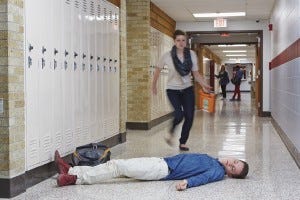Develop a Lifesaving Cardiac Emergency Response Plan for Your School
- Feb 16, 2016
- 0 Comments
Sudden Cardiac Arrest (SCA) affects roughly 326,000 people each year, including over 6,000 youth. During cardiac events, time becomes a critical factor. With each passing minute, an SCA victim’s chance for survival decreases by 7 to 10 percent.
Recently, a study that appeared in the
 Canadian Medical Association Journal showed that people who suffer cardiac arrest on the upper floors of high-rise buildings are less likely to survive than those on the lowest floors. The study found that less than 1 percent of people above the 16th floor survived a cardiac arrest, while over 4 percent of people on the first or second floor survived. The higher floors are associated with longer response times for EMS personnel to reach victims, and they directly correlate to lower survival rates.
Canadian Medical Association Journal showed that people who suffer cardiac arrest on the upper floors of high-rise buildings are less likely to survive than those on the lowest floors. The study found that less than 1 percent of people above the 16th floor survived a cardiac arrest, while over 4 percent of people on the first or second floor survived. The higher floors are associated with longer response times for EMS personnel to reach victims, and they directly correlate to lower survival rates.But these first minutes are critical whether a victim of SCA is in a tall building or a small community school. That’s why it’s important for both rural and urban communities to develop a planned response to a cardiac emergency, before the emergency occurs. Having a planned response that is known and rehearsed can help save precious minutes between an SCA event and when a victim begins to receive care.
To help prepare your school for a cardiac emergency, the Sudden Cardiac Arrest Foundation recommends having a Cardiac Emergency Response Plan in place. A Cardiac Emergency Response Plan is a written plan that establishes what steps to take if an SCA event happens in your school.
According to the SCA Foundation, the Cardiac Emergency Response Plan will help make sure that you can respond efficiently and effectively when a cardiac emergency occurs. Quick action in the first few minutes of a cardiac emergency, even by lay bystanders, can double or even triple a victim’s chance of survival.
With a Cardiac Emergency Response Plan, you can:
- Identify a Cardiac Emergency Response Team – The Cardiac Emergency Response Team should include staff members with CPR/AED training, the school nurse, school administrators, health and physical education teachers, athletic directors, athletic trainers, coaches, and event advisors. Each member of the team should be familiar with the plan, and provide evaluations and updates as necessary.
- Properly Place AEDs – The number of AEDs placed at a school should be sufficient to enable the response team to retrieve an AED and respond to a victim within two minutes of notification, both inside the school and on the school grounds. AEDs should have clear signage and should always be in locations that are accessible at all times. School Health offers a full line of AEDs and accessories to make sure that your school has the equipment you need.
- Ensure AED Readiness & Maintenance – AEDs should be regularly checked and maintained according to manufacturer’s recommendations. Schools should designate a specific contact to verify AED readiness and maintenance. In addition, resuscitation kits - including latex free gloves, a razor, a pair of scissors, antiseptic wipes, and a CPR barrier mask – should accompany all AED devices
- Establish Emergency Response Protocol – The Cardiac Emergency Response Team should establish a protocol to follow in case of a cardiac event. The protocol should include properly recognizing the signs of cardiac arrest, calling 911 and assigning someone to meet the emergency responders, starting CPR, and using an AED.
- Train Staff for Cardiac Events - The sooner an SCA victim receives care, including bystander CPR, the more likely they are to survive. An effective Cardiac Emergency Response Plan calls for at least 10 percent of school staff – including the school nurse – to be trained in CPR and AED use. This training should include both cognitive and hands-on practice, with continuous training that helps to ensure readiness in the event of a cardiac emergency. Products like the AHA’s CPR in School Training Kit can help ensure that your staff has the training that they need.
- Notify Parents – The Cardiac Emergency Response Team should notify parents that the school has adopted a Cardiac Emergency Response Plan, and encourage parents to be trained in CPR/AED use.
These carefully orchestrated responses to cardiac emergencies will help reduce deaths in school settings and can help ensure that chaos does not lead to an improper or inadequate response.
For more information about Cardiac Emergency Response Plans and insightful SCA information, please visit the Sudden Cardiac Arrest Foundation.
